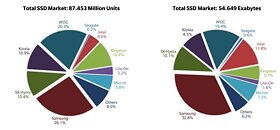Tuesday, February 16th 2021
333 Million SSDs Were Shipped in 2020, Accounting for 207 ExaBytes of Storage
Today we have one interesting research in our hands. According to Trendfocus inc. we have come to know that as much as 333 million Solid State Drives were shipped last year, in 2020. The SSDs have finally overcome HDDs in the number of shipped units, with HDDs shipping 260 million units. In terms of total capacity shipped, HDDs are still winning. The average SSD has less storage capacity compared to the average HDD, thus making the total shipped capacity of all 333 million SSDs "just" 207 Exabytes (EB), while the total shipped capacity of HDDs is a bit over one Zettabyte (ZB).
The average capacity of SSD was as much as 0.67 Terabytes (TB), while the average capacity of HDD was around 4.0 TBs. This is exactly why HDDs are still present as much - simply because they can store much more storage and offer better value as the price per Gigabyte ratio is much lower than the one of an SSD. The SSDs are experiencing Year-over-Year growth of 20.8% in unit shipments, while HDDs are declining at the rate of 18%. When it comes to the total storage capacity shipped on yearly basis, SSDs are growing at the rate of 50%, with HDDs growing at a 13% rate. You can also check out the SSD share of different vendors below.
Source:
Trendfocus
The average capacity of SSD was as much as 0.67 Terabytes (TB), while the average capacity of HDD was around 4.0 TBs. This is exactly why HDDs are still present as much - simply because they can store much more storage and offer better value as the price per Gigabyte ratio is much lower than the one of an SSD. The SSDs are experiencing Year-over-Year growth of 20.8% in unit shipments, while HDDs are declining at the rate of 18%. When it comes to the total storage capacity shipped on yearly basis, SSDs are growing at the rate of 50%, with HDDs growing at a 13% rate. You can also check out the SSD share of different vendors below.

18 Comments on 333 Million SSDs Were Shipped in 2020, Accounting for 207 ExaBytes of Storage
;)
But I do own 5y+ old SSD that's still in pretty good shape. Probably less than 10% wear.
SSD prices have gone down quite a bit in 2020 anyway if there truly is a shortage of memory chips in 2021 prices go up all bets are off beside occasional old ssd model dumps.